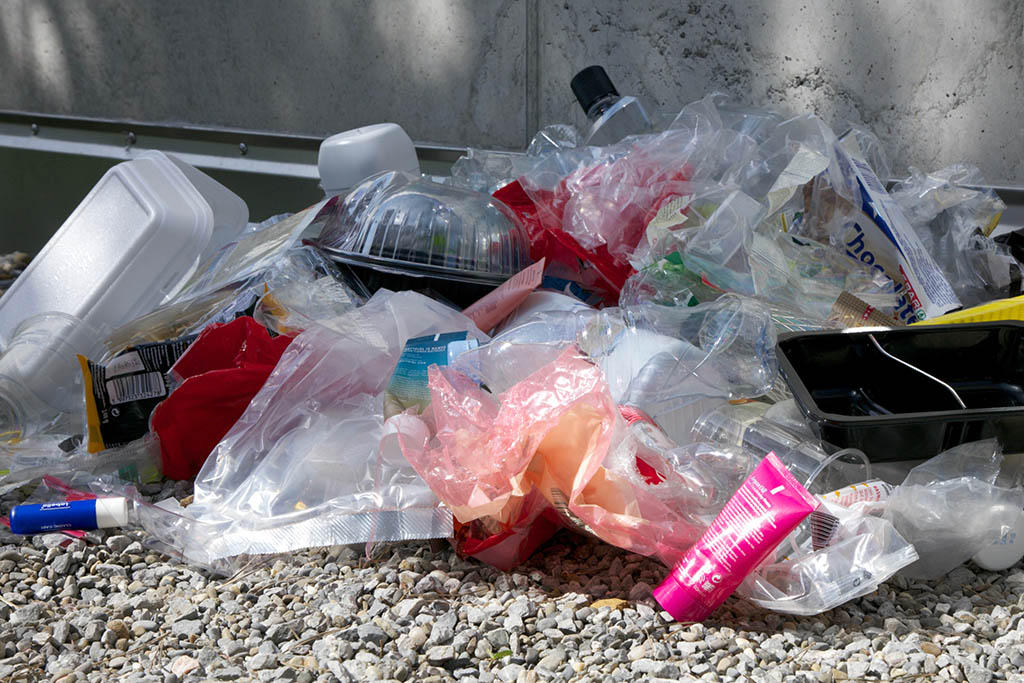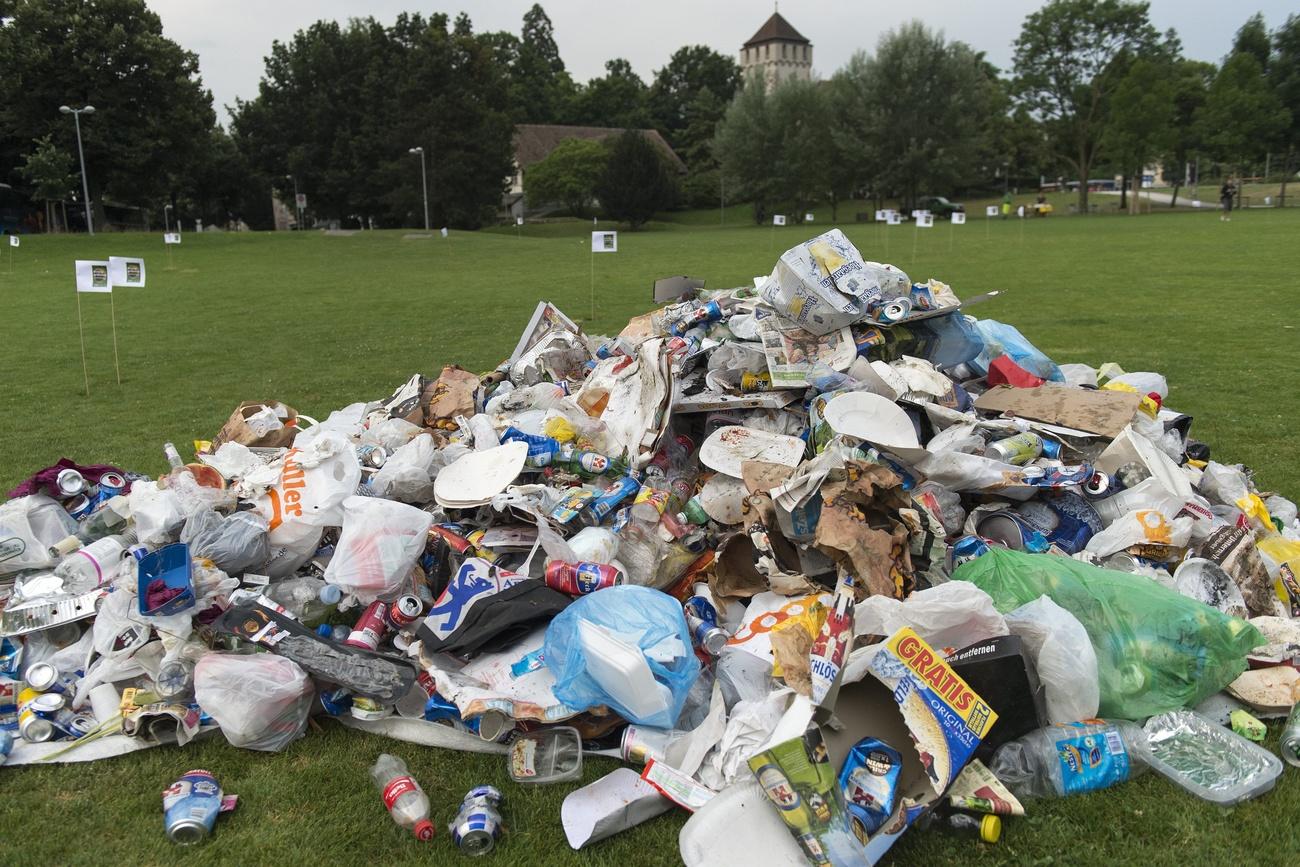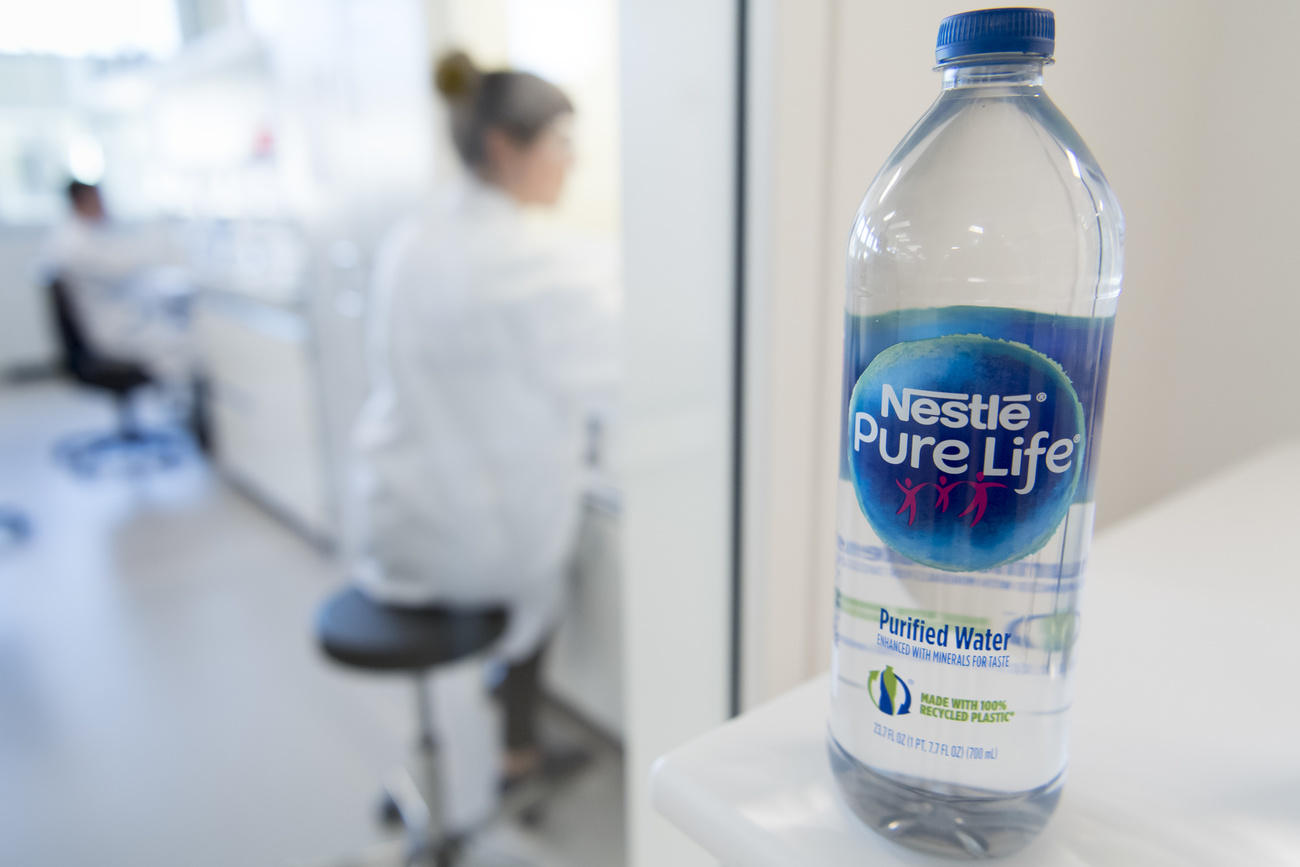How a Swiss sculptor is fighting plastic with art

An exhibit by artist Étienne Krähenbühl is a wakeup call about our daily use of plastic, which the artist sees as a material of perverse beauty that is ravaging the planet. But his work is also meant to explore solutions.
PLASTIQUES – ETIENNE KRÄHENBÜHL External linkis currently on show at the Centre d’art ContemporainExternal link in the western Swiss town of Yverdon-les-Bains.
The fresco of a fiasco
The prints that compose the colorful mosaic of the exhibition are telling a story: they are made from the silhouettes of the plastic food wrappings used by the artist and his wife over a year. From September 2017 to September 2018, their daily consumption was preserved, cleaned and weighed. The discarded plastics were then painted with inks of different colors by the artist and pressed flat between two sheets of cardboard to make prints from both sides.
The vaulted arches of the 18th-century granary that houses the contemporary art museum in Yverdon-les-Bains have been transformed into the visual representation of a modern-day catastrophe. The 730 prints, two for each day of plastic use, fill the entire 300 square metres of the hall. It’s a brutal and deceptively lovely reminder of a material that never completely disappears.
The production of plastic has increased 200-fold since the 1950s, says Karine Tissot, the Yverdon museum’s energetic director. In 2016 alone, the amount of virgin plastic produced equated to 53 kilograms of plastic for each person on the planet she says, citing a report from the World Wildlife FundExternal link. Tissot believes the world can no longer turn a blind eye to the problem, considering that plastic production generates 100 million tons of waste, 10% of which ends up in the sea.
She believes that it’s important for artists to join the engineers, oceanographers and entrepreneurs who are fighting the problem and is pleased that Étienne Krähenbühl is one of them.
The video below shows a concert from musicians Alexandre Cellier and friends that took place in the halls of the PLASTIQUES exhibition.
New explorations
Plastics are a new departure for an artist renowned for his sculptures in metal and wood, some of them monumental. An explorer at heart, Krähenbühl’s long-standing collaborations with numerous research labs have resulted in works that integrate shape-memory alloys and super-elastic metals to produce startling effects when the sculptures move, sometimes pushed by the wind alone. He is currently preparing an exhibition in New York.
Krähenbühl’s work with plastics came almost accidentally, the surprise outcome of his long-standing collaboration with a Swiss grand master of printmaking, Roland Meyer.
“It was serendipity,” Krähenbühl claims. They had just finished a meal in his workshop when Meyer challenged the artist to include a plastic yoghurt cup in the print that he was preparing. “It was the beginning of a voyage of discovery.”
Krähenbühl had already experimented with the reams of corrugated plastic wrapping that enveloped the alloys delivered to his studio, but he was frustrated by the outcome which he found too aesthetic – almost too pleasing – and lacking meaning.
“My decision to turn to food wrappings was not to make an ecological statement at first,” he says. “I was interested in what I could make out of them as an artist.”
He loved the transparency and fluidity that made him think of the sea. But he couldn’t ignore the fact that the byproduct of fossil fuels – which the earth has taken millions of years to produce – had become a major source of pollution that was devastating the ecosystem.
“Cousteau had already raised the alarm forty years ago, but when I started on this project in 2017, the awareness of the harm of plastics was just beginning.”
Marking time’s passage
But it was not enough for him to make art from trash. Krähenbühl was still looking for an added dimension to his project, which he found by correlating the colour of the inks to the local daily weather.
“I needed to anchor the prints in the passage of time,” he explains.
Krähenbühl’s oeuvre over the past 20 years has always revolved around the concept of time, with names like “Suspended time”, “Time squared”, “The flight of time” for his work. In French, the word is the same as that for “weather”, so he decided that each print would mirror the weather of the specific day it was made, adding a reference to the climate crisis and the warming of the planet to the prints. The colours he used, from blue for cold to orange for warm, would reflect the colour of the sky and interpret the temperature of the day.

Krähenbühl encountered many difficulties at the printing press because the plastics repelled the inks and produced pockets that would ruin the prints. So he worked their surfaces to make them permeable. The experience was exhilarating, he says, because the subject matter changed daily, as did the colour of the inks.
“But I never imagined that our 26 kilos of plastic rubbish would cover such a large surface!”
A new key to recycling
True to his past engagements, the artist sought to expand his project into science. Despite observing plastic pollution in waterways and its dramatic impact on ecosystems, he decided to remain hopeful.
“We are constantly confronted with beauty that can be destructive. Butterflies can utterly ruin a box bush; it’s the same thing with plastics.”
Krähenbühl thinks it’s useless to take on the industrial giants that produce plastic because there is still nothing as convenient and cheap to replace it. On the other hand, the search for alternatives is urgent. To that end, he has started a collaboration with Rudy Koopmans, director of the Plastics Innovations Competence Center (PICC) in the Swiss canton of Fribourg (see box).
Only 9% of plastics are recycled, Koopmans explains, while 12% are incinerated and 79% are buried. Since the planet is drowning in plastic bottles, diapers, single-use plastic bags and cigarette butts, solutions must be explored. The start-up he directs is experimenting a new generation of polymers made from organic biomass, as opposed to fossil fuels.
Plastics research in Fribourg
The Plastics Innovation Competence Center (PICC), part of the University of Applied Sciences and Arts Western Switzerland (HES-SO) and the School of Engineering and Architecture in Fribourg (HEIA-FR), positions itself to interact with key stakeholders in the plastics value chain. Multiple experts are engaged in proposing socially responsible, innovative and sustainable solutions to academia and industry. It is located in Fribourg, where Etienne Krähenbühl will be presenting the “dream of Icarus” project in May 2020.
Krähenbühl is already working on “The dream of Icarus”, a sculpture made from the polymers produced by Koopman’s laboratory from chicken feathers. The chicken industry burns 800 million tons of feathers every year, a biomass that can be put to better use, according to the artist and the scientist.
“These substitutes may not have the quality and transparency of the plastics that we know, but they are a good beginning,” Krähenbühl says hopefully.
PLASTIQUES, continued
In the meantime, the artist expects PLASTIQUES to travel. He dreams of presenting it in Japan, where he already has a following and where wrapping and packaging is such an exquisite art form. “We have so much to learn from the Japanese.”
He would also like to take it to Lebanon, where since 2000 he has made more than a thousand flowers out of the bits of shrapnel that litter the mountains around Beirut. Entitled Fleurs du mal (flowers of evil), the installation borrows from the French poet, Baudelaire, playing once again on the destructive paradox of beauty. The rubbish in Lebanon, regrets Krähenbühl, still gets dumped in the sea.
The sculptor is convinced that awakenings need not be riddled with guilt and defeatism. Shocking photos of gutted birds and whales may even alienate people, he believes. With PLASTIQUES, he is betting that beauty in art can also produce awareness and results.

In compliance with the JTI standards
More: SWI swissinfo.ch certified by the Journalism Trust Initiative











You can find an overview of ongoing debates with our journalists here . Please join us!
If you want to start a conversation about a topic raised in this article or want to report factual errors, email us at english@swissinfo.ch.